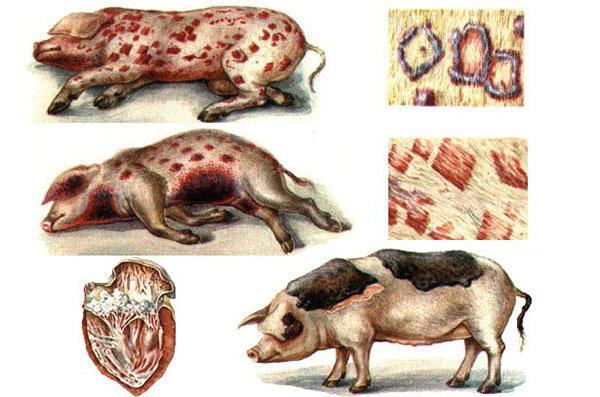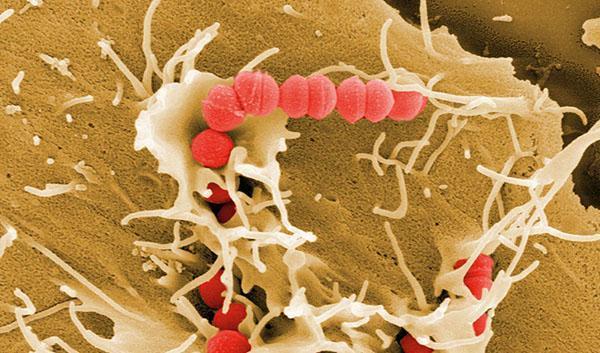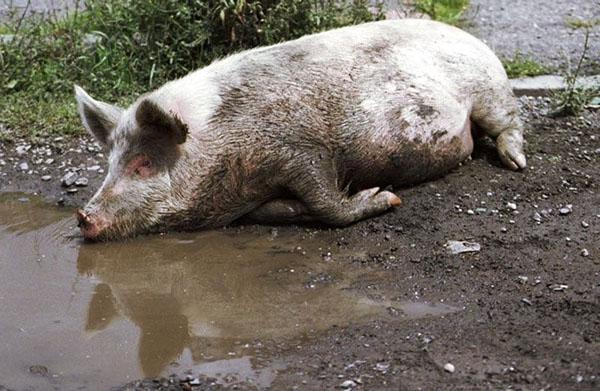Pig erysipelas disease is dangerous not only for animals
 Pig erysipelas, other than animals, is infectious to humans. Although the death of erysipelas of pigs can be isolated, its danger from this does not become less. The pathogenic erysipelas can provoke severe complications in humans and animals - diseases of the cardiovascular system, articular apparatus and morphological changes in internal organs. But with timely diagnosis and successful treatment, the negative consequences of this disease can be significantly reduced.
Pig erysipelas, other than animals, is infectious to humans. Although the death of erysipelas of pigs can be isolated, its danger from this does not become less. The pathogenic erysipelas can provoke severe complications in humans and animals - diseases of the cardiovascular system, articular apparatus and morphological changes in internal organs. But with timely diagnosis and successful treatment, the negative consequences of this disease can be significantly reduced.
Characteristics of erysipelas

Pig erysipelas is a common disease. It is registered as an epizootic (limited). Pigs are infected from 3 months to 1 year.
The source of the disease is sick pigs - bacteria carriers.
Transmission factors - meat from the slaughter of sick animals, contaminated slaughterhouse waste, manure, care items, corpses of sick animals. The pathogen is carried by mice, flies - by bloodsuckers. The transmission path is alimentary, it is rarely transmitted with transmission and direct contact.
Mostly pig erysipelas occurs in the warm season and is stationary.
The clinical picture of erysipelas
The incubation period ranges from 2 days to a week. Symptoms and treatment of swine erysipelas, the severity of its course and the form of the disease will depend on the factors contributing to the onset of the disease.
These factors include:
- virulence of the pathogen;
- gate of infection (place of entry of bacteria);
- the state of the animal's immune status;
- conditions of keeping and feeding.
The disease manifests itself in several forms that are characteristic of a certain course.
Classification of the course of the disease:
- lightning fast;
- spicy;
- subacute;
- chronic.
Each period (course) has its own picture of the disease.
Lightning current - is observed quite rarely. Its manifestation will be typical for fattening pigs for 7-10 months, in weakened animals that are kept in unsatisfactory conditions, under the influence of stress factors (transportation). There is no erythematous skin disease; erysipelas during this period is called the white form.
 The septic form is noted in acute course. During this period, sick animals are kept separate from the entire livestock, depressed, lie down. The body temperature is above 42 ° C, the limbs are bent with difficulty during movement (stilt gait). There is a loss of appetite, chills, dyspeptic disorders, diarrhea alternates with constipation. Vomiting attacks are possible.
The septic form is noted in acute course. During this period, sick animals are kept separate from the entire livestock, depressed, lie down. The body temperature is above 42 ° C, the limbs are bent with difficulty during movement (stilt gait). There is a loss of appetite, chills, dyspeptic disorders, diarrhea alternates with constipation. Vomiting attacks are possible.
Cardiovascular and renal failure cause pulmonary edema. Decompensatory shortness of breath, cyanosis (cyanosis) of the skin in the lower jaw, neck and abdomen develops. The characteristic symptom is erythema (redness) of the skin. On the second day of the disease, some pigs develop spots of different colors - from pale pink to dark red. If untreated, the sick die within 2 to 5 days.
 The erysipelas of pigs more easily passes in the subacute period, in which the skin form is characteristic - urticaria. The body temperature of a sick pig reaches 41 ° C, there is a weakening of the animal and thirst. With erythematous urticaria, swellings of various configurations are formed - square, diamond-shaped, sometimes round. Urticaria manifests itself in large areas of the body, while the course is benign. It disappears completely during treatment and recovery.
The erysipelas of pigs more easily passes in the subacute period, in which the skin form is characteristic - urticaria. The body temperature of a sick pig reaches 41 ° C, there is a weakening of the animal and thirst. With erythematous urticaria, swellings of various configurations are formed - square, diamond-shaped, sometimes round. Urticaria manifests itself in large areas of the body, while the course is benign. It disappears completely during treatment and recovery.
 The subacute course lasts 6 - 12 days, the outcome is favorable - recovery.
The subacute course lasts 6 - 12 days, the outcome is favorable - recovery.
It rarely becomes septic.
 The chronic form of pig erysipelas is rarely recorded. Manifested by erysipelas (necrosis) of the skin, warty endocarditis, rheumatism, polyarthritis. As a result, lameness develops and joints become deformed.
The chronic form of pig erysipelas is rarely recorded. Manifested by erysipelas (necrosis) of the skin, warty endocarditis, rheumatism, polyarthritis. As a result, lameness develops and joints become deformed.
Treatment
For a successful result and efficiency pig treatmentwith erysipelas should be complex. Apply specific and symptomatic therapy.
With specific therapy, patients are injected with an antiphosphorous serum. Symptomatic therapy includes the use of several groups of drugs:
- antibacterial broad-spectrum;
- vitamin;
- antihistamines;
- heart;
- antipyretic.
 Antimicrobial drugs (tylosin, tylosomikol, pharmacin, penicillin and streptomycin sodium salt) are used for 3 to 5 days. If necessary, continue the course of treatment with prolonged antibiotics (bicillin 3, 5). The optimal therapeutic effect can be achieved by combining antibiotics and antistatic serum at the same time. The dose of the drug is determined according to the instructions.
Antimicrobial drugs (tylosin, tylosomikol, pharmacin, penicillin and streptomycin sodium salt) are used for 3 to 5 days. If necessary, continue the course of treatment with prolonged antibiotics (bicillin 3, 5). The optimal therapeutic effect can be achieved by combining antibiotics and antistatic serum at the same time. The dose of the drug is determined according to the instructions.
Along with the use of medicines, they create an improved feeding and keeping of livestock. Places where sick people are kept are regularly mechanically cleaned and disinfected.
Measures for the control and prevention of erysipelas
 When pig erysipelas appears in the industrial and private sectors, restrictions are imposed. They relate to the export - import of pigs, export of non-disinfected products of pig production (meat) and feed.
When pig erysipelas appears in the industrial and private sectors, restrictions are imposed. They relate to the export - import of pigs, export of non-disinfected products of pig production (meat) and feed.
All livestock are subject to clinical examination. Pigs with a clinical picture are isolated and treated. Conditionally healthy - vaccinated and observed over the next ten days. In case of their illness, they are also isolated.
 If there is a need, sick pigs are slaughtered in designated areas.
If there is a need, sick pigs are slaughtered in designated areas.
Two weeks later, the restrictions are lifted after the last detection of the disease and the final forced disinfection of all rooms, equipment and walking areas.
Rules for eating meat
 Slaughter of pigs is allowed after the quarantine restrictions have been lifted.
Slaughter of pigs is allowed after the quarantine restrictions have been lifted.
Carcasses and products of slaughter of sick, ill and suspected of morbidity animals can be consumed only after boiling! And conducting a microbiological study for salmonellosis.
With pig erysipelas, meat can be eaten after treatment, but not earlier than the permissible withdrawal period. Withdrawal (waiting period) - the time of drug elimination from the animal's body.
 Due to a person's predisposition to the disease of erysipelas, it is necessary to strictly adhere to the rules of hygiene when slaughtering and cutting pork carcasses. Damaged skin increases the risk of erysipelas. Meat obtained from sick pigs or those who have been ill before eating should be heat treated - boiled. The above measures will avoid swine erysipelas.
Due to a person's predisposition to the disease of erysipelas, it is necessary to strictly adhere to the rules of hygiene when slaughtering and cutting pork carcasses. Damaged skin increases the risk of erysipelas. Meat obtained from sick pigs or those who have been ill before eating should be heat treated - boiled. The above measures will avoid swine erysipelas.
Very interesting excellent
What to do if a pregnant pig at 3 months gets sick with erysipelas? Will there be healthy piglets and miscarriage?
There is experience in treating erysipelas with a folk method with a positive result. You need to be patient. For treatment, you will need a talker made of yellow clay and milk return or whey.Water the animal with serum. Lubricate the animal with a clay talker. Apply a layer of clay all over the body. As soon as it starts to dry again, smear. Do this until the temperature drops. It took me a little over a day. I did it day and night.